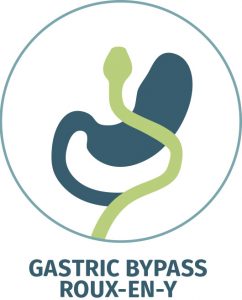
Roux-en-Y Gastric Bypass has been very popular overseas for many years. BodyFree offers this procedure at our clinic in Sydney. Roux-en-Y Gastric Bypass provides excellent long-term weight loss results.
What Is a Roux-en-Y Gastric Bypass?
Roux-en-Y is a Weight Loss Surgery procedure that reduces the size of the stomach and bypasses a section of the intestinal tract. This results in patients eating smaller portions, feeling less hunger, and losing weight sustainably over time.
The procedure is performed using a few small laparoscopic (keyhole) incisions. The surgeon then creates a small portion of narrow stomach, which is disconnected from the rest of the organ.
A portion of the small intestine is then brought up to be joined to this now-smaller portion of stomach. This allows the ingested food to “bypass” the majority of the stomach as well as the first 1-2 metres of the small intestine (most people have 4 metres or more of small intestine).
Roux-en-Y Gastric Bypass Surgery works by combining both restrictive and malabsorptive methods. By reducing the physical size of the stomach, patients become fuller faster and eat less. “Bypassing” a section of the intestine means the absorption of calories and nutrients consumed is reduced.
Roux-en-Y Gastric Bypass vs Sleeve Gastrectomy
BodyFree currently considers the Gastric Sleeve (Sleeve Gastrectomy) to be a superior solution, when taking into account quality of life considerations as well as the excellent weight loss results.
However, there are circumstances when we might recommend a Roux-en-Y.
A Roux-en-Y is considered for patients with poorly controlled Type II Diabetes Mellitus. While the Single Loop/Mini Gastric Bypass may offer better diabetes control for some patients, for others who suffer from problematic reflux symptoms, they may do better with a classical Roux-en-Y Gastric Bypass. Our surgeons will advise on your individual case.
We would also consider using a Roux-en-Y Gastric Bypass as a revision from a prior Bariatric surgical procedure, such as a Gastric Band or Gastric Sleeve/Sleeve Gastrectomy.
Who Needs a Roux-en-Y Gastric Bypass?
Patients who experience weight-related health problems, including Type 2 Diabetes, high blood pressure or high cholesterol, may benefit from a Roux-en-Y Gastric Bypass.
This procedure is an excellent weight loss solution that offers long term weight loss results.
As well as our guidelines here on how a Roux-en-Y could benefit your health, our surgical team will provide in-depth, individualised guidance in a consultation to see whether this procedure is right for you.
Roux-en-Y Gastric Bypass Surgery Pros and Cons
For those considering a Roux-en-Y Bypass, a consultation with the BodyFree surgical team will explore your personal circumstances and medical history to find the right weight loss solution for you.
Here, you’ll find our general guidelines on the benefits and risks of the Roux-en-Y procedure.
Pros
- Excellent weight loss success and long-term maintenance.
- Ideal for very poorly controlled Diabetes or Dyslipidemia (high cholesterol).
Cons
- At risk of medium- to long-term nutritional deficiencies, so may need some vitamin and nutritional supplements long-term.
- Can improve fertility in women, but slightly increase the risk of preterm and underweight birth neonates.
- Some patients may suffer from Dumping Syndrome, resulting in an intolerance to certain foods.
To begin your weight loss journey with BodyFree, call our clinic or contact us online.
What happens after Roux-en-Y Gastric Bypass Surgery?
Wound Care
After the Roux-en-Y procedure is complete, the small keyhole incisions are all closed with dissolving stitches. These are all placed under the skin, meaning patients will never need to see them.
We also use either tissue glue or steristrips and waterproof dressings to ensure the skin heals in a clean and dry environment. Patients can bathe or shower with these dressings in place; however, they should be patted dry afterwards.
The dressings are normally removed 10 days after surgery and the incisions should have healed nicely by then.
Pain Management
Most patients’ postoperative discomfort has settled at the time of discharge from the hospital. However, some Roux-en-Y patients may require a small amount of oral medication to help manage ongoing discomfort for a week or so. This can include Panadol, Panadeine Forte, Endone or occasionally other medicines.
Other Medicines
Routine medications can be recommenced as directed in the post-operative phase. Any blood-thinning agents that patients were previously taking will also be recommenced as directed by the medical team.
Many Roux-en-Y patients will be directed to take a PPI (Proton Pump Inhibitor) such as Nexium, Somac or Losec for a certain period after surgery, to reduce stomach acid production.
Your Post-Operative Diet
Roux-en-Y surgery will help patients to start their weight loss journey. However, in order to achieve successful long-term results, dietary and behavioural changes are necessary.
Every patient will be given specific dietary advice based on their personal requirements. The following are brief recommended guidelines for the diet plan following your Roux-en-Y Gastric Bypass Surgery.
Week 1
- Liquid nourishment
Weeks 2 – 4
- Pureed food
Week 4 +
- Commencement of soft solid diet.
** For more dietary information, you can speak to your BodyFree Dietitian, who will provide you with a comprehensive plan.
Roux-en-Y Recovery Time
As a guide, most patients need 2 nights in hospital post-op. Depending on the work in which you are employed, you’ll require anywhere from 3 to 14 days off work.
Most patients can start walking within a few days, and more vigorous exercise can commence within 3 weeks.
To book a Roux-en-Y consultation, contact BodyFree online now.
